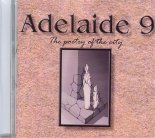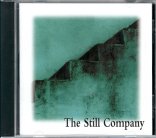Thylazine: The Australian Journal of Arts, Ethics & Literature #9/thyla9f-imbook
AUSTRALIAN POETRY BOOK REVIEWS
The Still Company by Ian McBryde and Greg Ridell
(The Still Company, Melbourne, VIC, Australia, 2002, ISBN: NA, $24.00)

|
These are two CDs which explore the way poetry can reinvent itself in the sound medium. Adelaide 9: The Poetry of the City is more conventional in that it presents a group of Adelaide poets reading their own work, though as the name of Mike Ladd (producer of the ABC program Poetica) immediately suggests, there are sound effects and some non-verbal interludes. What comes through is a quite dynamic sense of variety and assurance in the readings. Each poet comes over well and persuasively and there is certainly variety, light and shade, to make the disc something to play right through and enjoy. |
If we compare this recording of poets reading with the ancient (1970s) UQP records and tapes which pioneered the field what is instantly evident is that this is listener-friendly. Each poet has sufficient aural space to establish a voice and a personality, and as a sequence the presentation keeps the listener in there and attentive. The acoustic effects are minimal, but enhance the overall listening pleasure.
Of the individual poets, Mike Ladd is presented with absolute professionalism (natch!), David Ades has only two poems, but the second one, 'The Work of My Face', is quite long and benefits greatly from the "sound" of the reading. Ioana Petrescu has a sharp group of short poems, but there is no sense of crowding between them.
Shen writes poetry that, when transferred to sound, grows and grows. Rory Harris, Cath Kenneally, Stephen Lawrence and Heather Sladdin all contribute to the rich overall sense of individuality within an accepted vocal range. Ken Bolton is represented by a live reading back in 1986, with all the ripple of an active audience and the give-and-take of experiencing something here and now.
Adelaide 9 by Mike Ladd, David Ades, Ioana Petrescu, Shen, Rory Harris,
Cath Kenneally, Ken Bolton, Stephen Lawrence, Heather Sladdin
(SA Writers Centre, Adelaide, SA, Australia, 2003, ISBN: N/A, Free Promo CD!)

|
The Still Company is quite different. Here we have the poems of one author, Ian McBryde, who also plays the extensive drum sequences which are a dominant part of the listening experience. The words themselves are placed within a wider context of this drum ostinato and various other acoustic contributions. Sometimes the effect strongly enhances the overview of the poem context (especially the ostinato drumming, which locates the words in a framework of tension and intention). |
In the particularly haunting poem 'Testament' (track 6) the counterpoint of Lauren Williams's voice in its echo chamber and its contralto resonance gives the poem something quite impossible to conceive on the page. Ian McBryde's own voice has a consistent whispering edge, close to us but carefully remote.
His accent, interestingly, betrays no trace of his Canadian origins, though it is certainly not Australian either (nor British). It is a voice well placed to focus us on the sound values and the sense. Picaro Press, in their recent Wagtail 24, featured the poems of Ian McBryde and, after listening to this CD, it is fascinating how the poems on the page now seem to echo the personal cadence and the deliberate placement of the words.
There were only a couple of tracks which seemed to me not to work. The most obvious was No 9, 'Succubus', where the heavy breathing, slurping, and finally animal growling, had me hooting with laugher, where I suspect I was meant to be chilled by animal appetites. The only track free of the insistent drum patterning was the last one, 'Mayday', where it was a sort of relief to have only the sound of a clock ticking, and an occasional distant piano playing something that sounded like an echo of Satie perhaps. It made me think that 10 tracks in a row with that drumming beat might have been more effective had there been a little more variety for the listening ear.
(Reviewed by Thomas Shapcott, March 2004)
I Next I
Back I
Exit I
Thylazine No.9 (March, 2004) | |



